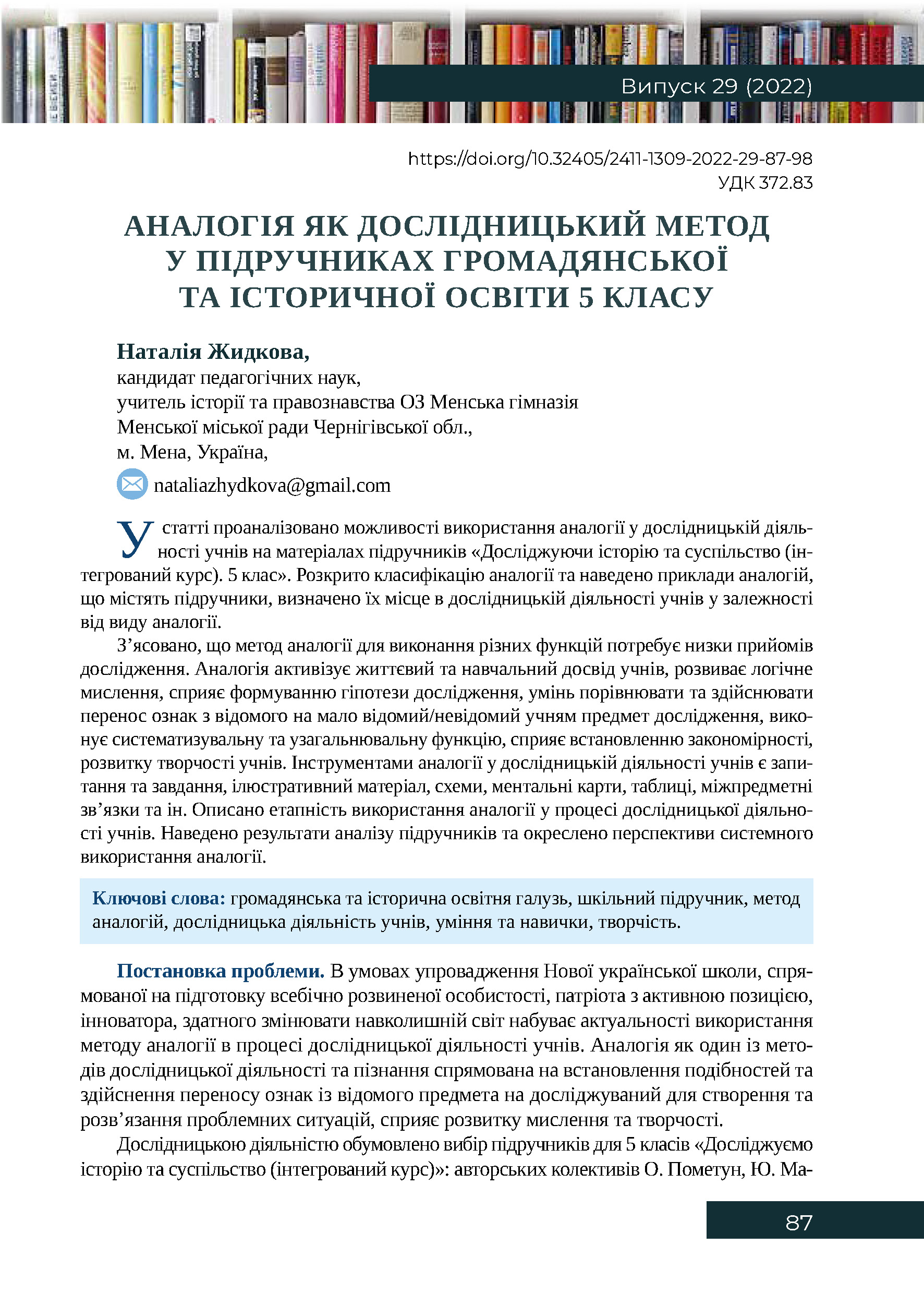Analogy as a Research Method in the Textbooks on Civic and History Education (Integrated Course) for 5th Grade

Published 2023-02-06
Keywords
- civic and historical branch of education,
- school textbook,
- method of analogies,
- research activity of students,
- research skills
- creativity ...More
How to Cite

This work is licensed under a Creative Commons Attribution-NonCommercial-ShareAlike 4.0 International License.
Abstract
The article analyzes the possibilities of using analogy in the research activities of students on the materials of the textbooks «Researching History and Society (integrated course). 5th grade». The classification of analogy is provided and examples of analogies contained in textbooks are given, their place in research activity is determined depending on the type of analogy.
It was found that the method of analogy to perform various functions requires a number of research techniques. Analogy activates students' life and educational experience, develops logical thinking, contributes to the formation of a research hypothesis, the ability to compare and carry out the transfer of features from a well-known to a little-known/unknown for students research subject, performs a systematizing and generalizing function, establishes regularities, promotes students' creativity. Tools of analogy in students' research activities are questions and tasks, illustrative material, diagrams, tables, intersubject connections, etc. The stages of the use of analogy in the process of students' research activities are described. The results of the analysis of the textbooks are presented and the prospects for the systematic and systematic use of analogy are outlined.
Downloads
References
- Бондар, І. (2018). Аналогія як явище в системі прогностичних методів у педагогіці. Науковий часопис НПУ ім.. М. Драгоманова. С. 17. Теорія і практика навчання та виховання, 8‒16.
- Васильків, І.Д., Басюк, О.Я., Гінкул, Г.С., Грисюк, Л.А., Димій, І.С., Іртищева, О.А., Костікова, М.І., Паршин, І.Л., Шеремета, Р.В. (2022). Досліджуємо історію і суспільство: підручник інтегрованого курсу для 5 класу закладів загальної середньої освіти. Тернопіль: Астон.
- Козловський, Ю.М., Козловська, І.М., Білик, О.С. (2021). Використання методу аналогії як засобу інтеграції міждисциплінарних знань. Педагогічні науки: теорія та практика, 3 (39), 32‒38.
- Костю, С.Й. (уклад.). (2018). Психологія творчості: курс лекцій з дисципліни для студентів денної форми навчання спеціальності 053 «Психологія». Мукачево: МДУ.
- Мороз, П., Мороз, І. (2020). Формування дослідницької компетентності засобами сучасного шкільного підручника історії. Проблеми сучасного підручника, (24), 142–162. https://doi.org/10.32405/2411-1309-2020-24-142-162
- Мороз, П.В., Мороз, І.В., Моцак, С І. (2022). Досліджуємо історію і суспільство. Інтегрований курс.: підручник для 5 класу закладів загальної середньої освіти. Київ: Педагогічна думка.
- Панарін, О., Макаревич, А., Топольницька, Ю., Охріменко О. (2022). Досліджуємо історію і суспільство: підручник інтегрованого курсу для 5 класу закладів загальної середньої освіти. Київ: Літера.
- Пилипейко С. (2016). Аналогії на уроках історії як засіб розвитку мотивації до навчання. Рідна школа, 8‒9, 32‒36. http://nbuv.gov.ua/UJRN/rsh_2016_8-9_10
- Пометун, О., Малієнко, Ю., Ремех, Т. (2022). Досліджуємо історію і суспільство: підручник інтегрованого курсу для 5 класу закладів загальної середньої освіти. Київ: Видавничий дім «Освіта».
- Рижко, О.М., Савченко, О.В. (2001). Аналогія. Енциклопедія Сучасної України: електронна версія, гол. редкол.: І.М. Дзюба, А.І. Жуковський, М.Г. Железняк та ін.; НАН України, НТШ. Київ: Інститут енциклопедичних досліджень НАН України. https://esu.com.ua/search_articles.php?id=44045